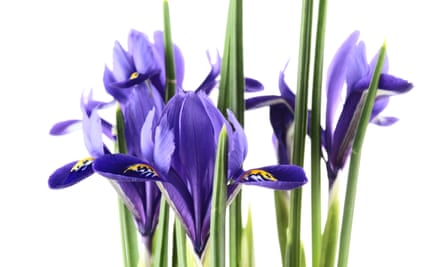I have been preparing for the long nights ahead, resisting White Lotus and the latest seasons of Sex Education; instead, I have demijohns of marrow rum gently bubbling away, and I have bought some Iris reticulata “Harmony” bulbs. I will plant them in shallow bowls to bring indoors to flower during January, when the sight of such delicate beauty will sustain me after the box sets are finished and the rum is drunk dry.
I would have bought more than just these – I would have filled the house with forced hyacinths and paperwhites narcissus, but I have yet to find a source of organically grown versions. So it’s all on the shoulders of the humble I. reticulata “Harmony” to keep me buoyed up over the darkest months.

In the wild, I. reticulata grows in Russia, through the Caucasus and into northern Iran, where it is found in sunny spots on cold, dry mountains with free-draining soil. The spring’s snow melt provides moisture for early growth, but after that, conditions dry out and this is the key to longevity for the bulbs in our gardens. A wet autumn and winter spot will rot the bulbs, so add sand or grit to heavier soils, along with leaf mould or well-rotted homemade compost, to ensure the best blooms.
Indoors is a slightly different matter. Go for a few smaller terracotta pots, or one large centrepiece in a wide shallow bowl. If you want to give your grandmother’s porcelain bowl a new life, add drainage holes using a fine tile drill bit that will do the job without it cracking.
You’ll need good-quality, peat-free compost mixed with grit for drainage, roughly three parts compost to one part grit. For the best displays, plant the bulbs 5cm deep, but close together – you can get 10-15 bulbs in a container 22cm across. To force the bulbs, keep the container somewhere cool, dark and out of the rain. If you don’t have a shed, leave it outside with a larger pot on top for cover. They need about 10 weeks of this treatment, so if you get to it pronto, you can bring them inside to flower in January.
In a pretty pot they make lovely Christmas gifts, and it’s a great project for kids. Once indoors, keep them somewhere light and they’ll grow at an extraordinary rate, up to 6cm in 24 hours. The blooms are gently scented too. You can buy bulbs online from Natural Bulbs and Organic Bulbs.
Once the blooms are finished, store the pot outside to allow the leaves to die back naturally. Once this has happened, keep them somewhere they won’t get drenched if it’s a wet summer so you can bring them back indoors next autumn. Or plant them 10cm deep and the same distance apart in your garden.
